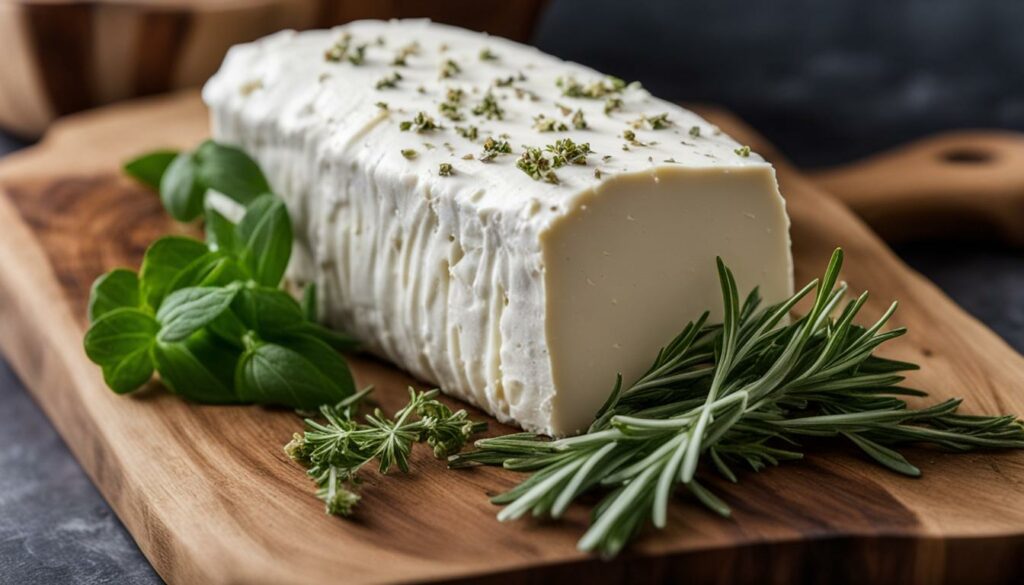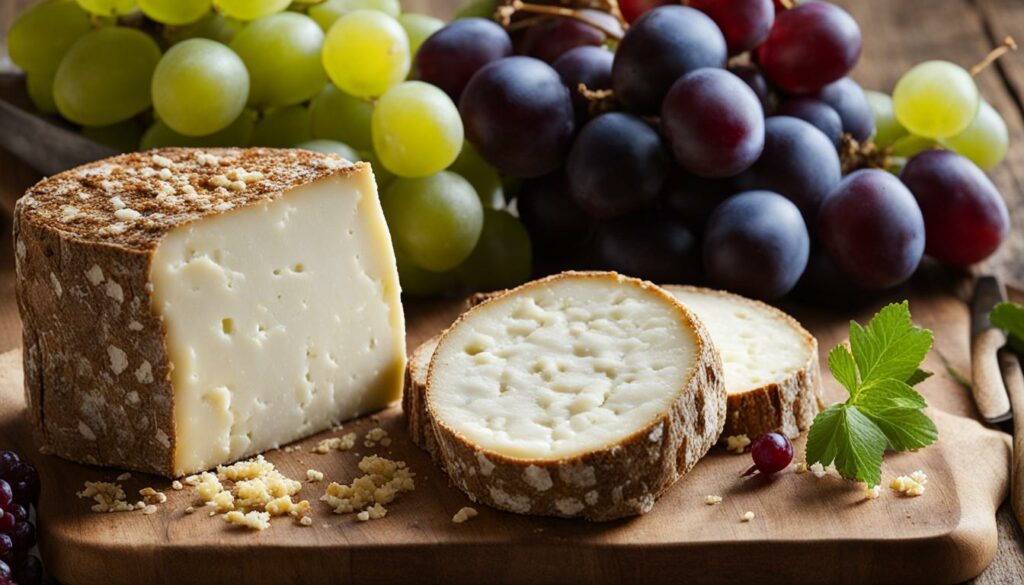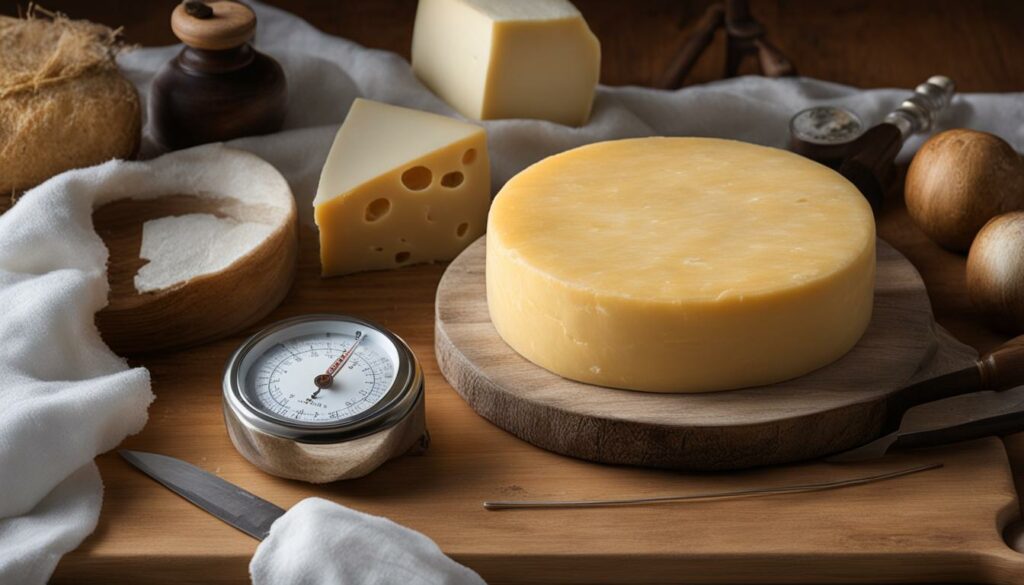Welcome to our comprehensive guide on the delectable world of chevre log cheese! If you’re a fan of soft goat cheese, you’re in for a treat. From its smooth and tangy flavor to its versatility in various dishes, chevre log cheese is a true delight for cheese enthusiasts. Whether you’re indulging in a gourmet cheese log or exploring the artisanal craftsmanship behind this creamy goat cheese, we have all the information you need to enhance your cheese experience.
So what exactly is chevre log cheese? It’s a log-shaped cheese made from goat’s milk that offers a rich and creamy texture. Its buttery and tangy flavor profile makes it an excellent addition to everything from appetizers to pasta sauces. And with its numerous health benefits, including higher vitamin and mineral content and easier digestibility, chevre log cheese is a great choice for those who are lactose intolerant or looking for a healthier option.
In this guide, we’ll dive into the world of goat cheese, exploring the different types available, tips on how to buy and store it, and even a few delicious recipes to tantalize your taste buds. So get ready to savor the creamy goodness of chevre log cheese as we embark on this flavorful journey together.
What is Goat Cheese?
Goat cheese, also known as chevre, is cheese made from goat’s milk. The term chevre is often used to describe any type of goat cheese, but it is commonly associated with fresh goat cheese. Fresh goat cheese is unaged, soft, and often sold in a log shape. It has a buttery and tangy flavor with a creamy texture that is easily spreadable at room temperature. In addition to fresh goat cheese, there are also soft ripened and aged varieties. Soft ripened goat cheese can range from mild to funky, while aged goat cheese is harder and may have a crumbly or crystalline texture.

Goat cheese is a versatile and delicious option for cheese lovers. Its unique flavor profile and texture make it a popular choice in both savory and sweet dishes. Whether you’re enjoying a simple goat cheese log spread on crackers or incorporating soft ripened goat cheese into a salad, the possibilities are endless.
Soft ripened goat cheese adds a creamy and tangy element to dishes and pairs well with fruits, nuts, and honey. Aged goat cheese, on the other hand, brings a stronger and more complex flavor that can elevate any cheese board or charcuterie platter.
Not only does goat cheese taste great, but it also offers some nutritional benefits. It is lower in fat and calories compared to cow’s milk cheese, making it a healthier option for those watching their intake. Goat cheese is also a good source of calcium, protein, and vitamins, making it a nutritious addition to your diet.
In summary, goat cheese, or chevre, is a delicious and versatile cheese made from goat’s milk. From fresh goat cheese logs to soft ripened and aged varieties, there is a goat cheese for every palate. Its unique flavor and creamy texture make it a popular choice in both savory and sweet dishes. So go ahead, indulge in the creamy delights of goat cheese and embrace its rich and tangy flavors.
How to Buy Goat Cheese
When it comes to buying goat cheese, there are a few key factors to keep in mind. Whether you’re looking for fresh goat cheese or aged varieties, it’s important to know what to look for to ensure you’re getting the best quality and flavor. Here are some guidelines to help you make the right choice:
1. Fresh Goat Cheese:
When purchasing fresh goat cheese, look for these characteristics:
- Bright white color
- Firm texture
- Available in logs or tubs
These attributes indicate that the cheese is fresh and will have a creamy and tangy flavor.
2. Aged Goat Cheese:
If you prefer a more intense and complex flavor, aged goat cheese is the way to go. When buying aged goat cheese, follow these tips:
- Visit the cheese counter for a wide selection
- Choose cheese wrapped in paper or wax paper
- Store in the refrigerator drawer for up to 1 week
Aged goat cheese develops deeper flavors over time, making it perfect for a cheese board or adding a unique touch to your favorite recipes.
3. Storage Tips:
To maintain the freshness and flavor of your goat cheese, here’s what you need to do:
- Unopened fresh goat cheese that is vacuum-packed in plastic can last up to 2 months refrigerated.
- Once opened, remove the cheese from the packaging and store it in a sealed container in the fridge.
These storage practices will help prevent any unwanted flavors or spoilage, ensuring that your goat cheese stays delicious for longer.
By following these guidelines, you can confidently navigate the world of goat cheese and bring home the perfect selection for your culinary adventures.

Benefits of Goat Cheese
When it comes to cheese, goat cheese stands out with its unique taste and texture. But did you know that goat cheese also offers numerous health benefits? Let’s explore why adding this delicious cheese to your diet can be a smart and tasty choice:
Rich in Essential Nutrients
Goat cheese is packed with essential vitamins and minerals that are beneficial for your overall health. It contains high levels of vitamins A and B, which play a vital role in maintaining good vision, supporting immune function, and promoting cell growth. Additionally, goat cheese is a good source of calcium, iron, magnesium, and potassium, which are all necessary for maintaining strong bones and muscles.
Lower in Calories
If you’re watching your calorie intake, goat cheese can be a great option. Compared to many cow-based cheeses like mozzarella, Swiss, and cheddar, goat cheese contains slightly fewer calories while still providing that creamy and satisfying flavor. This makes it a wonderful choice if you’re looking for a healthier alternative without sacrificing taste.
Digestibility and Lactose Intolerance
One of the biggest advantages of goat cheese is its digestibility, especially for those with lactose intolerance. Goat’s milk naturally contains less lactose than cow’s milk, making it easier for your body to break down and digest. Additionally, the protein structure of goat’s milk differs slightly from cow’s milk, making goat cheese a gentler option for those with digestive sensitivities.

| Comparison of Nutritional Values (per 100g) | Goat Cheese | Mozzarella Cheese | Swiss Cheese | Cheddar Cheese |
|---|---|---|---|---|
| Calories | 364 | 248 | 380 | 403 |
| Vitamin A (IU) | 805 | 238 | 630 | 1059 |
| Vitamin B12 (mcg) | 1.7 | 0.5 | 0.5 | 0.3 |
| Calcium (mg) | 327 | 731 | 941 | 721 |
| Iron (mg) | 1.6 | 0.3 | 0.7 | 0.2 |
Table: Nutritional comparison of goat cheese with other popular cheeses
As you can see, goat cheese not only delights your taste buds but also provides you with a range of health benefits. Its nutrient-rich composition, lower calorie content, and easy digestibility make it an excellent addition to your meals. So go ahead, indulge in the creamy and tangy goodness of goat cheese!
Substitutes for Goat Cheese
If you don’t have goat cheese on hand or prefer to use a different cheese in your recipes, there are several substitutes available. Cream cheese, ricotta cheese, feta cheese, and labneh can all work as alternatives to goat cheese depending on the specific recipe.
Cream cheese: Cream cheese can serve as a creamy substitute for goat cheese. It has a smooth texture and mild flavor that pairs well with various dishes.
Ricotta cheese: Ricotta cheese offers a similar creamy texture and is a great substitute for goat cheese in recipes like dips, pastas, and desserts.
Feta cheese: Feta cheese provides a tangy and salty flavor profile that can mimic the taste of goat cheese. It works well in salads, sandwiches, and as a topping for roasted vegetables.
Labneh: Labneh, a strained yogurt cheese, is an excellent alternative for recipes that require a spreadable cheese, such as dips or sandwich spreads. It has a tangy and creamy consistency that is similar to goat cheese.
Experiment with these substitutes to find the best option for your dish. Each cheese brings its own unique flavor and texture, allowing you to create delicious recipes even without goat cheese.

How to Make Homemade Goat Cheese
Making homemade goat cheese is easier than you might think. With a few simple ingredients and tools, you can create your own delicious and creamy goat cheese right at home.
To make homemade goat cheese, you will need the following ingredients:
- Goat milk
- Water
- Citric acid
- Salt
- Any desired flavorings or herbs
In addition to the ingredients, you will also need the following tools:
- Pot
- Thermometer
- Strainer
- Cheesecloth
- Container for straining the cheese
Now, let’s go through the process of making homemade goat cheese step-by-step:
- Heat the goat milk in a pot until it reaches a specific temperature.
- Add citric acid to the goat milk and stir to encourage the separation of curds and whey.
- Strain the curds using a cheesecloth-lined strainer to separate them from the whey.
- Allow the cheese to strain for a few hours until it reaches the desired texture.
- Add salt and any flavorings or herbs to enhance the taste of your goat cheese.
Once you’ve followed these steps, you’ll have a batch of homemade goat cheese ready to enjoy. It’s perfect for spreading on crackers, using in salads, or incorporating into your favorite recipes.
Check out the visual guide below for a better understanding of the process:
| Step | Image |
|---|---|
| 1. Heat the goat milk |  |
| 2. Add citric acid and stir |  |
| 3. Strain the curds |  |
| 4. Let the cheese strain |  |
| 5. Add salt and flavorings |  |
So why not give homemade goat cheese a try? It’s a rewarding and delicious endeavor that allows you to savor the unique flavors of artisanal cheese right in your own kitchen.
Recipe: Warm Goat Cheese Appetizer
Looking for a crowd-pleasing appetizer that’s both creamy and delicious? This warm goat cheese appetizer is the perfect choice for any gathering or entertaining occasion. With the combination of tangy goat cheese, sweet apricot marmalade, crunchy pistachios, and fresh thyme, this dish is sure to impress your guests.
To make this mouthwatering goat cheese appetizer, you will need the following ingredients:
- A goat cheese log
- Orange apricot marmalade (or any other flavor of your choice)
- Finely chopped pistachios
- Fresh thyme
Preheat your oven to the desired temperature and spread the apricot marmalade in a small baking dish. Place the goat cheese log on top of the marmalade and add some more preserves on top. Bake the dish for about 10 minutes until the cheese is warm and softened.
Once the goat cheese is warm and gooey, top it off with finely chopped pistachios and fresh thyme for extra flavor and crunch. Serve the appetizer with crostini, bread, or crackers, allowing your guests to dip and savor every creamy bite.
This warm goat cheese appetizer is not only incredibly delicious but also visually appealing, making it a stunning addition to your table. The combination of creamy goat cheese, sweet apricot marmalade, nutty pistachios, and aromatic thyme creates a flavor explosion that will have everyone coming back for more.
Whether you’re hosting a dinner party or simply want to treat yourself to something special, this warm goat cheese appetizer is a must-try. The creamy texture of the goat cheese, paired with the sweetness of the apricot marmalade and the nuttiness of the pistachios, is a true delight for the taste buds.
So go ahead and impress your guests with this irresistible warm goat cheese appetizer. It’s the perfect way to start any meal or gather around with friends and family. Enjoy the delicious combination of flavors and textures while creating unforgettable memories.
Recipe: Homemade Herb-Infused Chevre Cheese
Indulge in the delightful flavors of homemade herb-infused chevre cheese. Made with either goat milk or cow milk, this recipe allows you to create your own creamy and flavorful cheese right from your kitchen. The combination of fresh herbs, white wine vinegar, and a touch of salt elevates the taste to a whole new level.
To make this herb-infused chevre cheese, gather the following ingredients:
- Goat milk or cow milk
- Heavy cream
- Fresh herbs of your choice (such as rosemary, thyme, or basil)
- White wine vinegar
- Salt
Instructions:
- In a pot, combine the milk, cream, and fresh herbs. Heat the mixture over medium heat until it reaches a temperature of 180°F (82°C). Stir occasionally to prevent scorching.
- Once the desired temperature is reached, remove the pot from the heat. Add a splash of white wine vinegar and stir gently to combine. Let the mixture sit undisturbed for 10 minutes.
- After 10 minutes, the mixture will have separated into curds and whey. Line a strainer with cheesecloth and place it over a bowl or container to catch the whey.
- Gently pour the curds and whey into the cheesecloth-lined strainer. Allow the cheese to strain for at least 2 hours, or until it reaches your desired consistency. You can let it strain for longer if you prefer a drier cheese.
- Once the cheese has reached the desired consistency, transfer it to a bowl. Add salt to taste and mix well to incorporate.
- If desired, you can also add additional flavorings such as garlic, lemon zest, or black pepper.
Your homemade herb-infused chevre cheese is now ready to enjoy! Spread it on crackers, top pizzas, or use it as a delicious addition to your favorite dishes. The creamy texture and herb-infused flavors will elevate any meal or snack.
Note: When using goat milk, the cheese will have a slightly tangy and earthy flavor. If you prefer a milder taste, you can use cow milk instead.
With just a few simple ingredients and a little patience, you can create your own homemade herb-infused chevre cheese. Impress your guests with this flavorful and versatile cheese, or savor it on your own for a gourmet treat.
How to Store Goat Cheese
Proper storage is important to maintain the quality and freshness of goat cheese. Whether you have fresh goat cheese or aged goat cheese, follow these guidelines for optimal storage:
Storing Fresh Goat Cheese
Fresh goat cheese should be stored in a sealed container in the refrigerator and consumed within one week of opening.
- Transfer the fresh goat cheese from its original packaging to an airtight container.
- Ensure the container is tightly sealed to prevent air exposure.
- Label the container with the date of opening for easy reference.
- Store the container in the refrigerator, preferably in the cheese drawer or the coldest part of the fridge.
- Consume the fresh goat cheese within one week of opening for the best taste and texture.
Storing Aged Goat Cheese
Aged goat cheese should be wrapped in paper or wax paper and stored in the refrigerator drawer for up to one week.
- Remove the aged goat cheese from any plastic packaging or wrapping.
- Wrap the cheese tightly in wax paper or parchment paper.
- If using wax paper, secure it with tape or a rubber band to prevent air exposure.
- Label the wrapped cheese with the type and date of purchase.
- Store the aged goat cheese in the refrigerator drawer, where it can maintain a consistent temperature.
- Aged goat cheese is best enjoyed sooner rather than later for optimal flavor.
Always check for any signs of spoilage, such as mold or unpleasant odors, before consuming goat cheese. Proper storage will help preserve the quality and taste of your goat cheese, ensuring a delightful culinary experience.
| Storage Method | Storage Duration |
|---|---|
| Storing Fresh Goat Cheese in a sealed container in the refrigerator | Up to 1 week |
| Storing Aged Goat Cheese wrapped in paper in the refrigerator drawer | Up to 1 week |
Conclusion
Goat cheese, also known as chevre, is a versatile and delicious option for cheese lovers. Whether you prefer the fresh and tangy flavor of chevre log cheese or want to explore the world of ripened and aged varieties, goat cheese offers endless possibilities for culinary creations.
One of the key advantages of goat cheese is its higher nutrient content compared to cow’s cheese. Packed with vitamins, minerals, and healthy fats, goat cheese is a creamy delight that adds a nutritious boost to any meal. Additionally, goat cheese is easier to digest, making it a perfect choice for those with lactose intolerance.
By learning how to make homemade goat cheese, you can experience the joy of creating your own artisanal cheese. With just a few ingredients and tools, you can whip up a batch of creamy and flavorful goat cheese that will impress your family and friends.
So why not indulge in the rich flavors and creamy texture of goat cheese? Whether you incorporate it into a cheese board, use it as a spread on your favorite crackers, or try out one of the tasty recipes mentioned in this guide, goat cheese is sure to delight your taste buds and elevate your culinary experience.
FAQ
What is goat cheese?
Goat cheese, also known as chevre, is a creamy and versatile cheese made from goat’s milk. It comes in various forms, including fresh, soft ripened, and aged.
How do I buy goat cheese?
When buying goat cheese, look for bright white and firm fresh cheese or explore different varieties of ripened and aged goat cheese.
What are the benefits of goat cheese?
Goat cheese offers several benefits compared to cow’s cheese. It is richer in essential nutrients and is easier to digest for many people, even those with lactose intolerance.
What are some substitutes for goat cheese?
Cream cheese, ricotta cheese, feta cheese, and labneh can all work as alternatives to goat cheese depending on the specific recipe.
How do I make homemade goat cheese?
To make homemade goat cheese, you will need goat milk, water, citric acid, salt, and any desired flavorings or herbs. Heat the milk, add the citric acid, strain the curds, and let it sit until the desired texture is achieved.
What is a recipe using goat cheese?
A popular recipe is a warm goat cheese appetizer, which involves baking a goat cheese log with apricot marmalade, pistachios, and fresh thyme.
How should I store goat cheese?
Fresh goat cheese should be stored in a sealed container in the refrigerator and consumed within one week of opening. Aged goat cheese should be wrapped in paper or wax paper and stored in the refrigerator drawer for up to one week.







